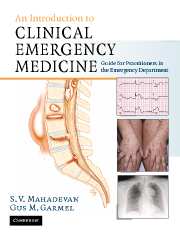Book contents
- Frontmatter
- Contents
- List of contributors
- Foreword
- Acknowledgments
- Dedication
- Section 1 Principles of Emergency Medicine
- 1 Approach to the emergency patient
- 2 Airway management
- 3 Cardiopulmonary and cerebral resuscitation
- 4 Cardiac dysrhythmias
- 5 Shock
- 6 Traumatic injuries
- 7 Prehospital care and emergency medical services
- 8 Pain management
- Section 2 Primary Complaints
- Section 3 Unique Issues in Emergency Medicine
- Section 4 Appendices
- Index
8 - Pain management
Published online by Cambridge University Press: 27 October 2009
- Frontmatter
- Contents
- List of contributors
- Foreword
- Acknowledgments
- Dedication
- Section 1 Principles of Emergency Medicine
- 1 Approach to the emergency patient
- 2 Airway management
- 3 Cardiopulmonary and cerebral resuscitation
- 4 Cardiac dysrhythmias
- 5 Shock
- 6 Traumatic injuries
- 7 Prehospital care and emergency medical services
- 8 Pain management
- Section 2 Primary Complaints
- Section 3 Unique Issues in Emergency Medicine
- Section 4 Appendices
- Index
Summary
Scope of the problem
Acute pain is the most common complaint of patients presenting to the emergency department (ED), comprising 60% of presenting complaints in one study. Recognition and acknowledgment of a patient's pain, adequate treatment, and timely reassessment are essential to acute pain management in the ED. Unfortunately, it has been demonstrated that many physicians fail to treat pain promptly or adequately in both inpatient and outpatient settings.
Pain
Pain is whatever the experiencing person says it is, existing whenever he or she says it does. The International Association for the Study of Pain defines pain as “an unpleasant sensory and emotional experience associated with actual or potential tissue damage, or described in terms of such damage,” “always subjective,” and “learned through experiences related to injury in early life.” Pain includes behavioral and physical indicators, in addition to self-report. Thus, preverbal, nonverbal, or cognitively-impaired individuals who experience pain can benefit from objective pain assessment. Fear and anxiety increase the perception of physical pain – the unfamiliar and frequently unfriendly ED environment does little to ameliorate a patient's pain.
Acute pain is a symptom of injury or illness, which serves the biologic purpose of warning an individual of a problem and limiting activities that might exacerbate it. Acute pain is usually associated with identifiable pathology and causes anxiety. By convention, it is present for less than 6 months.
Chronic, malignant pain is associated with a terminal disease, such as cancer or acquired immune deficiency syndrome (AIDS).
- Type
- Chapter
- Information
- An Introduction to Clinical Emergency MedicineGuide for Practitioners in the Emergency Department, pp. 131 - 142Publisher: Cambridge University PressPrint publication year: 2005

